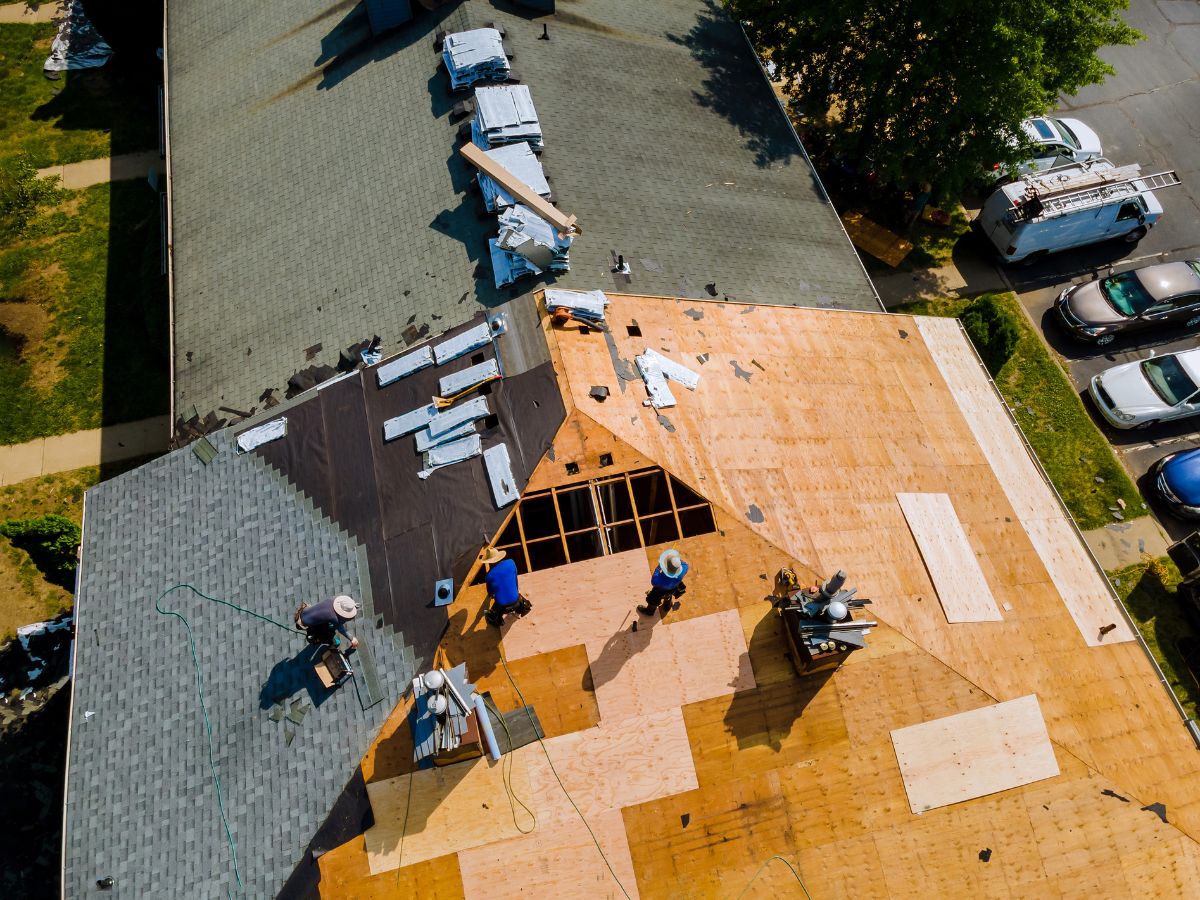Roof replacement includes essential materials such as shingles, underlayment, flashing, and ventilation systems. Skilled labor is vital for proper installation and to ensure long-lasting protection. The process begins with inspecting the roof for underlying issues, then removing old materials without damaging the structure. After checking and repairing the deck, new roofing is installed. Additionally, factors like material choice and labor costs can greatly influence the overall expense. There is much more to understand about this comprehensive process.
Key Takeaways
- Complete roof replacement includes removing old roofing materials and inspecting the underlying structure for damage.
- Key materials used in replacement are shingles, underlayment, flashing, and ventilation systems.
- Proper installation requires skilled labor to ensure durability and performance of the new roof.
- Ventilation systems are checked and installed to prevent moisture buildup and extend roof lifespan.
- The process also involves additional costs for labor, material selection, and potential removal fees for existing roofing.
Complete Roof Replacement Overview of Materials and Labor
A complete roof replacement involves several essential materials and skilled labor to ensure a

durable and effective roofing system. Homeowners should be aware of what is included in roof replacement, which typically encompasses shingles, underlayment, flashing, and ventilation systems.
Every part helps protect the house from weather conditions. Additionally, proper installation requires experienced professionals who understand the intricacies of roofing.
The complete roof replacement cost can vary based on materials chosen and the complexity of the roof structure. People who own homes frequently look for confidence that their financial commitment will provide enduring safeguarding and visual attractiveness.
Understanding these materials and labor requirements can foster a sense of belonging within the community of informed homeowners. By knowing what to expect, individuals can make confident decisions, ensuring their homes remain safe and welcoming for years to come.
Step-by-Step Roof Replacement Process for Homeowners

Understanding the materials and labor involved in a roof replacement lays the groundwork for homeowners to navigate the process effectively. A step by step roof replacement begins with a thorough inspection, identifying any underlying issues that must be addressed. Next, the old roofing material is carefully removed, ensuring no damage occurs to the underlying structure.
Once stripped, the deck is inspected, repaired if necessary, and prepared for new installation. Following preparation, underlayment is laid down to provide additional protection against moisture.
Then, new shingles or tiles are installed, starting from the lower edge and working upwards to ensure proper water flow. Flashing is added around vents and chimneys to prevent leaks.
Finally, ventilation is checked to guarantee optimal airflow. This roofing replacement process not only rejuvenates the home but also fosters a sense of security and belonging for the family within.
Roofing Replacement Process for Long-Term Durability

While embarking on a roof replacement project, homeowners must prioritize long-term durability to ensure the new roofing system withstands the test of time and weather conditions.
Selecting high-quality materials—such as durable shingles, efficient underlayment, and reliable flashing—is essential for a resilient roof.
The process begins with a thorough removal of the old roofing, allowing for an inspection of the underlying structure. This step is crucial as it can reveal hidden issues that need addressing before proceeding.
Proper ventilation must also be installed to prevent moisture buildup, further extending the roof’s lifespan.
Homeowners often wonder, “How often should a roof replacement occur?” A well-executed complete roof replacement can last 20 years or more, depending on the materials chosen.
Complete Roof Replacement Cost Factors to Consider

When planning a complete roof replacement, several cost factors must be carefully considered to ensure a realistic budget. Homeowners should evaluate aspects such as material choice, labor costs, and additional features. Understanding these elements helps in making informed decisions.
| Cost Factors | Description |
| Material Type | Different materials vary in price. |
| Labor Costs | Skilled labor can significantly impact overall expenses. |
| Roof Size | Larger roofs require more materials and labor. |
| Removal Fees | Existing roof removal adds to total costs. |
| Additional Features | Skylights or ventilation can increase expenses. |
What Is Included in Roof Replacement for a Complete Project

A comprehensive roof replacement project encompasses several critical components that ensure the longevity and effectiveness of the new roofing system.
Initially, the process begins with the removal of the old roofing materials, allowing for a thorough inspection of the underlying structure. Any damaged wood or insulation may be replaced to provide a solid foundation.
Next, essential materials such as underlayment, shingles, flashing, and ventilation systems are installed. The underlayment acts as a moisture barrier, while flashing protects vulnerable areas from leaks. Proper ventilation is crucial for regulating temperature and preventing moisture buildup.
Finally, the installation is completed with meticulous attention to detail, ensuring seams are sealed and features are aligned. Homeowners can expect a final inspection to guarantee that all work meets quality standards.
How Often Is Roof Replacement Needed in Harsh Climates

Roof replacement how often should it be considered by homeowners in harsh climates? In regions characterized by extreme weather, such as heavy snowfall, intense heat, or frequent storms, the lifespan of roofs can be significantly reduced. Generally, a roof may need replacement every 15 to 25 years in these environments, depending on the materials used and the severity of the climate.
| Climate Type | Replacement Frequency |
| Heavy Snowfall | Every 15-20 years |
| Intense Heat | Every 20-25 years |
| High Winds | Every 15-20 years |
| Humid Conditions | Every 15-20 years |
| Coastal Areas | Every 15 years |
Homeowners should be proactive, regularly inspecting their roofs and considering replacement sooner if signs of wear appear. Being informed fosters a sense of community and responsibility among homeowners facing similar challenges.
FAQ: Roof Replacement Essentials
How long does a roof replacement take?
Most roof replacements take 1 to 3 days, depending on factors like roof size, weather conditions, material type, and the complexity of the structure. Larger homes or roofs with multiple layers may take longer, while straightforward jobs can be completed quickly with an experienced crew.
Will my roof decking be replaced during a roof replacement?
Only if necessary. During the tear-off process, contractors inspect the roof decking for signs of rot, water damage, or structural issues. If the decking is compromised, those sections will be replaced to ensure a strong foundation for the new roofing materials.
Is underlayment necessary in roof replacement?
Yes, underlayment is a critical component of any roof replacement. It acts as a moisture barrier between the roof deck and shingles, providing added protection against leaks, ice dams, and wind-driven rain. Skipping underlayment can compromise the roof’s durability and may void manufacturer warranties.
Should I stay home during roof replacement?
You can stay home, but be prepared for significant noise and vibrations throughout the day. If you work from home, have pets, or prefer a quieter environment, consider making alternative arrangements. Always consult with your contractor about safety protocols and accessibility during the project.
Final Thoughts
A roof replacement is a significant investment that goes beyond simply swapping old shingles for new ones. It involves thorough inspections, structural repairs, high-quality materials, and skilled labor to ensure long-term durability and protection. Understanding what is included in a roof replacement—from underlayment to ventilation—empowers homeowners to make informed decisions and plan effectively for costs. If you’re budgeting for your project, be sure to consider all roof replacement cost factors in Houston, from material selection to labor and removal fees.
Whether your roof is aging or has suffered storm damage, Texas Stag Roofing Solutions is here to help. Contact us today to schedule your free inspection and experience the difference our quality, integrity, and expertise can make for your home.


